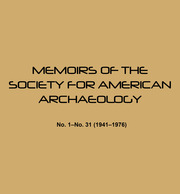Article contents
Demographic Studies in Southwestern Prehistory
Published online by Cambridge University Press: 27 June 2018
Extract
In this Essay, I will focus on inferences about the size of prehistoric populations based on estimates of the quantity of space utilized by those populations. I wish to recognize at the outset that there are many other data bases that have been employed by archaeologists in making inferences about prehistoric demography. While I do not intend to question the validity of alternative data bases for making paleo-demographic inferences, there are reasons why I believe that utilized space is potentially our most significant data base. Let us consider some of the alternatives.
(1) Simulation models. Simulation models are powerful tools for gaining insight into the demography of prehistoric populations. Yet, if the implications of such models are to be tested, a means of making direct inferences about the population of prehistoric groups is needed.
(2) Burial populations. Burial populations are likely to remain the data base from which the most comprehensive demographic inferences can be made. However, there are many areas of the world in which burial populations are so rare that one cannot count on using this data base. In addition, Cook (1972) and Baker and Sanders (1973) have identified a number of significant limitations on the utility of burial data.
- Type
- Research Article
- Information
- Copyright
- Copyright © Society for American Archaeology 1975
References
- 5
- Cited by


